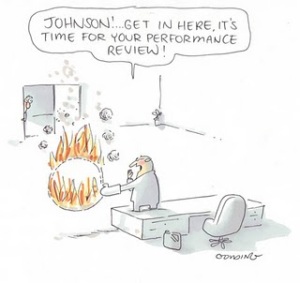This blog’s topic looks at a cherished belief of many executives that pay for performance compensation schemes motivates people to higher performance. Yet, pay is just one thread in a tapestry that covers the state of motivation in organizations today.
(Listen to Walk the Talk – Radio for Agile Minds – The Pay for Performance Myth )
In this piece, I want to challenge manager’s over-reliance on paying for sales performance to stop relying on this apparently sensible idea and. Let’s rethink what effective management has to offer in creating a Motivating Environment.
Just to give you how addicted US Companies are to pay-for-performance; here’s a couple of statistics:
- Average incentive income for US Salespeople is 40% of their total compensation.
- Overall, 85% of this group work under some type of pay for performance compensation plan.
W. Edwards Deming (1982) “Pay is not a motivator” He called the system by which merit is appraised and rewarded:
“The most powerful inhibitor to quality and productivity in the Western World”…..”it nourishes short-term performance, annihilates long-term planning, builds fear, demolishes team work, nourishes rivalry and…leaves people bitter”
“Money can nevertheless be a demotivator” Frederick Hertzberg
Pay for performance advocates obsess about “How should people be paid?” But it is not as important as managers think and is in fact a distraction from the things that really matter.
The real issue is how do people become motivated to produce competitively superior results:
Managers ask: ‘How do you motivate people? – Answer is ‘You Don’t’ (Douglas McGregor)
So, if you see books like “How to Motivate your work force” “Making People Productive” can be safely passed over because the enterprise it describes in wholly misconceived.
Of course, you can get people to perform using rewards, punishments and operational controls. But, the desire to do it well, simple cannot be imposed. It’s a mistake to talk about motivating other people. All Managers can do is set up conditions that can develop an interest in what they are doing and remove constraints to their improvement.
What are the ways of creating The Motivating Environment?
Probably one of the best authors in this field , Alfred Kohn, stated three Basic Principles.
Pay people generously and equitably – Do your best to make sure they don’t feel exploited. Then, do everything in your power to help them put m oney out of their minds! Problem with incentives is not that people are offered too much. It’s that money is pushed in people’s faces and offered transactionally, e.g. “You do this and you will get that” Getting rid of conditionality is the first step in fixing what’s wrong
oney out of their minds! Problem with incentives is not that people are offered too much. It’s that money is pushed in people’s faces and offered transactionally, e.g. “You do this and you will get that” Getting rid of conditionality is the first step in fixing what’s wrong
- The trouble with money is not itself per se but with the way people are made to think about money and the way it is use to control them.
- We need to decouple the task from compensation
“For the love of money is the root of all kinds of evil… (People) craving money have wandered from the truth and pierced themselves with many sorrows… (1 Timothy 6:10)
OK. So, how should you pay people, other than well and fairly?
A good starting point is asking yourself:
What makes some people more valuable to the organization that most will see as fair and achievable? (e.g. not based on being a family member- LOL) Examples:
- Time employed
- Special skills, professional qualifications
Deming, most Japanese and other countries follow this philosophy and now a minority of US Companies – the gradual realization that pay-for-performance is an inherently flawed concept.
But, what do you do about paying people if they perform better than their peers?
Well, it leads to another common practice of linking pay to the outcome of the dreaded annual performance appraisal. This is typically a stressful annual ritual and should have been retired long ago. OK. So what do we replace it with?

Let’s look at a second principle to creating the Motivating Environment, let’s Refocus Evaluation. An obvious question:
Why are people being evaluated? Possible answers:
- “Performance Evaluation persists as a effective tool for controlling employees…(that) should not be confused…with motivation of employees”
- It allows supervisors to shift the responsibility for solving problems to their subordinates
“Using Performance appraisal of any kind as a basis for reward is a flat out catastrophic mistake” (Peter Scholtes)
It is “foolish to have a manager in the self-conflicting role as a counselor (helping improve performance) when at the same time, he or she is presiding as a judge over the employee’s salary…”(Herbert Meyer)
The Insight is that the entire process of providing feedback, assessing progress, and developing development plans ought to be completely divorced from salary determinations. Such sessions must have no rewards or punishment hanging in the balance.
So, how do you get genuine motivation?
It’s a good question How do you create conditions for authentic motivation?
Significantly Alan Binder pulled all available research on this subject, Paying for Productivity: A Look at the Evidence and concluded:
“Changing the way workers are treated may boost productivity more than changing the way they are paid”
Or to put it another way:
The Pay Cart is in front of the Motivation horse. Motivation produces results not pay.
In surveys there is a broad consensus on what managers should do to create the Motivation Environment:
- WATCH: Don’t put employees under surveillance; look for problems that need to be solved and help people solve them.
- LISTEN: Attend seriously and respectfully to workers’ concerns
- TALK: Provide plenty of informational feedback as opposed to judgmental feedback. People need to reflect on what they doing right, to learn what needs improving, and discuss how to change
- THINK: why do you use power they way you do?
What do managers need to be careful of when dealing with performance improvement?
The main failing we see in our work is the extent to which rewards are not made contingent on some specific desired behaviour change that impacts business performance. Many clients are concerned about the very subjective nature of rating performance and therefore allocating performance related pay equitably. Often we start by comparing the client’s existing competencies with how they rate performance with those selected from the PDS Competency Library. Candidly, the Client’s Competencies are a mixture of Competencies and Attributes. “So what,” you say. Bottom line, you hire attributes and develop competence! Typical definitions:
- Competent: “The ability to do something successfully or efficiently.”
- Competency: ”Having the necessary ability, knowledge, or skill to do something successfully:”
- Attribute: “A characteristic or quality of a person.”
Frequently, Competencies of ten contain a mixture of attributes which should be part of the recruitment and selection process, around which you choose a path of development for each individual. Relying on attributes as a basis for incentives naturally leads to the problem of subjectivity in performance ratings. Too many times people are swimming around in a sea of ink and rhetoric when it comes to recognizing and developing leadership and other competencies? Is more being written and discussed than applied to create the Motivating Environment?
ten contain a mixture of attributes which should be part of the recruitment and selection process, around which you choose a path of development for each individual. Relying on attributes as a basis for incentives naturally leads to the problem of subjectivity in performance ratings. Too many times people are swimming around in a sea of ink and rhetoric when it comes to recognizing and developing leadership and other competencies? Is more being written and discussed than applied to create the Motivating Environment?
Many authors of Competencies are not clear as to what a competency really is. (Is it a skill? Is it a behavior? Is it knowledge? Or, is it a value?). For example: A competency that deals with diversity has been described this way; “sensitivity to different races, cultures, nationalities, sexes and disabilities”. Many would agree this competency is more of a value (attribute). However, if that is the case, developing this competency presents a formidable challenge, since values tend to evolve over a lifetime.
The difficulty we have in agreeing on what competencies are required is practically dwarfed by the complexity of the motivational and therefore, the competency development challenge. Of course, the beliefs and customs of a culture play an incredibly significant role in influencing beliefs, attitudes and values. We have to recognize that behavior can be adapted, but attitudes and values are relatively rigid.
What we now know about competencies shows that matching behavior patterns and attitudes of people to the demands of a position is crucial to creating the Motivational Environment
This knowledge can also assist organizations to understand the challenges in trying to get people to adapt their natural behavior patterns and attitudes to accommodate organizational needs. Recognizing that competencies are configurations of behavior, attitudes, beliefs, knowledge, intelligence and skills are essential in the people evaluation and development process.
It is a truism that if individual talents are matched with the most important job requirements it can create optimal motivation and therefore superior performance. People whose natural behavior matches the requirements of their jobs and are rewarded for their true aspirations and passions naturally:
- Perform better
- Enjoy the intrinsic rewards of their work
- Are loyal and enthusiastic
- Often need to be told to go home
The main responsibilities in managing these people are to:
1. Keep them informed to align their efforts with changes
2. Make sure the building is open
3. Make sure they have the resources to do their job
4. Encourage them to maintain balance with activities outside of work.
As a rule, a “hands-off” leadership style tends to work best with people who are well matched to their positions. Micro-management or command and control techniques may drive these people to the competition. Although this kind of a “hand-in-glove” fit between people and positions may be difficult to maintain in the face of continuous change, the effort promises to return rich dividends in terms of self-directed performance, positive morale and commitment.
The matching process starts by identifying position requirements in terms of the competencies required for superior performance (built on and around attributes, whatever they may be). Every effort must be made to ensure this process is objective. Position requirements must be analyzed in terms of:
- Behavior
- Competencies (including soft as well as hard skills)
- Attitudes (attributes)
- Knowledge or experience.
An objective process for analyzing position requirements is needed whether the focus is leadership or management, technical, professional or driving a truck. What does this mean in terms of assessing the context, skills, competencies, attitudes and experience?
Summary
Creating the Motivation Environment and produce competitively superior results relies not so much on pay for results but these key factors:
- Build a firm foundation for your organization based on values, principles, servant leadership,
- Create and reinforce a “needs-driven” purpose or mission that is consistent with potential employees philosophy and values.
- Skip incentive pay and pay people fairly or even generously for the position,
- Hire good life skills (attributes) and teach job skills (competencies).
It is crucial to properly matching peoples’ gifts, talents, expertise and passions to the job.
- Hire the “right” person for the “right” job,
- Coach positively for improved competence, and avoid annual performance appraisals which are linked to pay
- Develop servant leadership that clears away the barriers to people’s success and avoids command and control leadership
Tip of the Blog
Ask yourself:
- Do you have competencies for those positions which are crucial to your organization’s performance?
- How well do they separate the Knowledge, Skills that are developable vs. those attributes that you need when hiring or promoting?
- Honestly, how well are these attributes used to objectively anchor the recruitment process?
(Listen to Walk the Talk – Radio for Agile Minds – The Pay for Performance Myth )
Great, but how can this help me?
How about asking us? The first call is free! Just email me to set it up. Don’t wait, get The Crispian Advantage working for you!. If our conversation leaves you needing more, we offer at a reasonable fee telephone and video coaching on change, alignment, personal and executive performance that improve the bottom line. If that still doesn’t do it, we’ll work with you on a solution.
© Copyright All Rights Reserved, The Crispian Advantages, [2010-2011]. Unauthorized use and/or duplication of this material without express and written permission from this blog’s author and/or owner is strictly prohibited. Excerpts and links may be used, provided that full and clear credit is given to Nick Anderson, The Crispian Advantage with appropriate and specific direction to the original content.
Related articles
- Creating a virtuous loop in pay-for-performance (sarahdillard.wordpress.com)
- What Is The Difference Between Pay for Performance and Accountable Care Organizations (diseasemanagementcareblog.blogspot.com)

